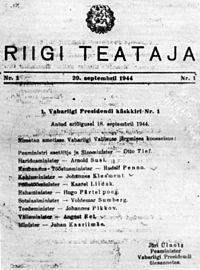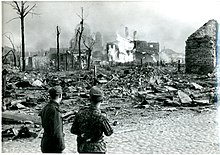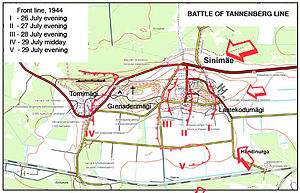Battle of Narva (1944)
[8] A number of foreign volunteers and local Estonian conscripts participated in the battle as part of the German forces with Army Group North.
[9] As a continuation of the Leningrad–Novgorod Offensive of January 1944, the Soviet Estonian operation pushed the front westward to the Narva River, aiming to destroy "Narwa" and thrust deep into Estonia.
Stalin's main strategic goal—a quick recovery of Estonia as a base for air and seaborne attacks against Finland and an invasion of East Prussia—was not achieved.
As a result of the tough defence of the German forces, the Soviet war effort in the Baltic Sea region was hampered for seven and a half months.
The elevation above sea level in the area is rarely above 100 meters, and the land is cut by numerous waterways, including the Narva and Plyussa rivers.
The Soviet winter campaign included major assaults along the entire expanse of the front in the Ukraine, Belorussia, and the German Panther Line, in the Baltic Sea region.
Success in the Estonian operation would have provided an unobstructed route to advance along the coast to Tallinn, forcing the German Army Group North to escape from Estonia for fear of getting cornered.
[14][15] Stalin ordered the capture of Narva at all costs no later than 17 February:[16] After the failure of the Leningrad Front, Stalin issued a new order on 22 February: to break through the "Narwa" defence, give a shock at Pärnu, eliminate the German forces in Estonia, direct two armies at Southeast Estonia, keep going through Latvia, and open the road to East Prussia and Central Europe.
[1] This position was the northern segment of the German Panther Line and it was where Generalfeldmarschall Georg von Küchler, in charge of the Army Group, wanted to set up his defence.
Using that freedom to his advantage, Model managed to fall back and begin establishing a line along the Narva River, with a strong bridgehead on the eastern bank in Ivangorod.
As President Konstantin Päts was imprisoned by the Soviet authorities, the acting head of state, according to the Constitution, was the former Prime Minister Jüri Uluots.
The German-appointed Estonian Self-Administration had previously made several unsuccessful general mobilisation calls, which were illegal under the Hague Conventions (1899 and 1907) and opposed by Uluots.
[24][25] In February 1944, when the Leningrad Front reached the vicinity of Narva and the Soviet return became a real threat, Uluots switched his stand on the German draft.
[1] Forward units of the 2nd Shock Army crossed the river and established several bridgeheads on the west bank to the north and south of the city of Narva on 2 February.
The 2nd Shock Army expanded the Krivasoo Bridgehead in the raised bog south of Narva five days later, temporarily cutting the Narva–Tallinn Railway behind the III SS Panzer Corps.
At the same time, the Soviet 108th Rifle Corps landed units across Lake Peipus 120 kilometres south of Narva and established a bridgehead around the village of Meerapalu.
The fresh SS Volunteer Grenadier Regiments 45 and 46 (1st and 2nd Estonian) accompanied by units of the "Nordland" Division destroyed the Soviet bridgeheads north of Narva by 6 March.
The newly arrived 59th Army attacked westwards from the Krivasoo Bridgehead and encircled the strong points of the 214th Infantry Division and Estonian 658th and 659th Eastern Battalions.
An air and artillery shock of 100,000 shells and grenades at the "Nordland" and "Nederland" detachments in Ivangorod prepared the way for the 30th Guards Rifle Division's attack on 8 March.
[1][10] The Strachwitz Battle Group annihilated the Soviet 8th Army shock troop wedge at the western end of the Krivasoo Bridgehead on 26 March.
Generalmajor Hyacinth Graf Strachwitz von Groß-Zauche und Camminetz, inspired by the success, tried to eliminate the whole bridgehead but was unable to proceed due to the spring thaw that had rendered the swamp impassable for the Tiger I tanks.
[1][10] The Soviet breakthrough in Belorussia and Karelian Offensive forced the Army Group North to withdraw a large portion of their troops from Narva to the central part of the Eastern Front and to Finland.
In a pitched battle carried over to the next day without a break in the fighting, the two Soviet armies forced "Narwa" into new positions at the Grenadier Hill, the central one.
Steiner, the commander of the III SS Panzer Corps, sent out the remaining seven tanks, which hit the surprised Soviet armour and forced them back.
The 2nd Shock Army was back to 20,000 troops by 2 August while numerous attempts using unchanged tactics failed to break the multinational defence of the "Narwa".
With the Soviet offensive at Riga threatening to complete their encirclement, the Army Group North started preparations for the withdrawal of troops from Estonia in an operation codenamed Aster.
The lengthy German defence during the Battle of Narva denied the Soviets the use of Estonia as a favorable base for amphibious invasions and air attacks against Helsinki and other Finnish cities.
Finnish Chief of Defence Carl Gustav Emil Mannerheim repeatedly reminded the German side that in the event their troops in Estonia retreated, Finland would be forced to make peace even on extremely unfavourable terms.
Thus, the prolonged Battle of Narva helped Finland avoid a Soviet occupation, sustained its capacity for resistance and enabled them to enter negotiations for the Moscow Armistice on their own terms.
On 1 August 1944, the national committee pronounced itself Estonia's highest authority and on 18 September 1944, acting head of state Uluots appointed a new government led by Otto Tief.




